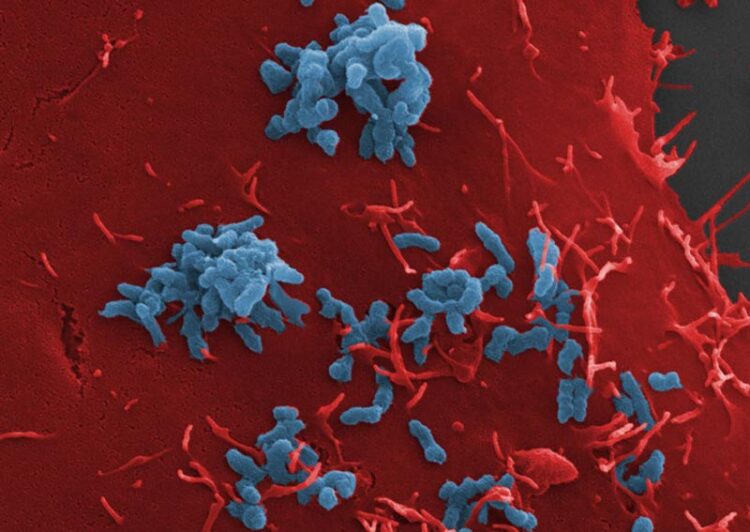Infection research: Antibodies prevent cell infection

Adhesion of Bartonella henselae (blue) to human blood vessel cells (red). The bacterium's adhesion to the host cells could be blocked with the help of so-called “anti-ligands". Credit: https://www.mdpi.com/2075-4418/11/7/1259
Using bacteria of the Bartonella henselae species, researchers from Goethe University, Frankfurt University Hospital, the Paul Ehrlich Federal Institute for Vaccines and Biomedicines in Langen, and the University of Oslo demonstrated for the first time that antibodies can prevent certain surface proteins of bacterial pathogens from entering host cells. The findings are important for the development of new drugs against highly resistant infectious agents.
Infections, especially those with highly resistant pathogens, pose a significant threat to human health. It is dangerous when pathogens manage to colonize the organism and subsequently cause severe infections. The first step in such an infection always consists of the pathogens attaching themselves to the host cells’ surface. From here, the infections spread, resulting, for example, in infections of deeper tissue layers and organs.
A group of scientists surrounding Prof. Volkhard Kempf from Frankfurt University Hospital’s Institute of Microbiology and Hospital Hygiene has now succeeded in blocking this adhesion mechanism in a bacterium, thereby preventing the infection of host cells. For this purpose, the researchers examined the pathogen Bartonella henselae, usually causing cat scratch disease. Transmitted by cats, the disease mainly affects young children, whose symptoms include swollen and hardened lymph nodes around the site of infection – usually following a scratch or bite injury caused by infected cats.
Bartonella bacteria infect so-called endothelial cells, which line the blood vessels. Via their surface protein Bartonella adhesin A (BadA), they attach themselves to a protein (fibronectin) of the so-called “extracellular matrix”, a network of protein fibers that lie on top of the endothelial cells.
To determine which parts of the BadA protein are important in the bacterial adhesion process, the researchers equipped Bartonella bacteria with various genetically modified BadA variants, among others, and then analyzed the extent to which these variants were still able to bind fibronectin. Once it was clear which BadA segments were responsible for the binding, the team produced antibodies against them, using cell culture experiments to show for the first time that such antibodies can prevent infection by such bacteria.
Prof. Volkhard Kempf explains: “Bartonella henselae is not a very dangerous pathogen, and in most cases, cat scratch disease does not require any specific medical treatment. However, for us Bartonella henselae is a very important model organism for far more dangerous pathogens such as Acinetobacter baumannii, a serious pathogen that usually causes wound infection or pneumonia and often shows resistance to several last-choice antibiotics. The BadA protein of Bartonella henselae belongs to the so-called ‘trimeric autotransporter adhesins’, which are also responsible for adhesion to human cells in Acinetobacter and a number of other pathogens. A drug-induced blocking of these adhesins is therefore a promising novel and future approach to combat dangerous bacterial infections.”
The research was supported by the Viral and Bacterial Adhesin Network Training (ViBrANT) program; a HORIZON 2020 research and innovation program of the European Union under the Marie Skłodowska-Curie grant agreement; the Robert Koch Institute, Berlin, Germany; the “PROXYDRUGS” project of the Federal Ministry of Education and Research; as well as the German Research Foundation DFG.
Picture download:
https://www.kgu.de/fileadmin/redakteure/Presse/Bilder_Pressmitteilungen/2022/Bar…
Caption: Adhesion of Bartonella henselae (blue) to human blood vessel cells (red). The bacterium’s adhesion to the host cells could be blocked with the help of so-called “anti-ligands”. Credit: https://www.mdpi.com/2075-4418/11/7/1259
Wissenschaftliche Ansprechpartner:
Professor Volkhard A. J. Kempf
Director of the Institute of Medical Microbiology and Hospital Hygiene
University Hospital Frankfurt
Goethe University Frankfurt
Phone: +49 (0)69 6301–5019
volkhard.kempf@kgu.de
Website: https://www.kgu.de/einrichtungen/institute/zentrum-der-hygiene/medizinische-mikr…
Originalpublikation:
Arno Thibau, Diana J. Vaca, Marlene Bagowski, Katharina Hipp, Daniela Bender, Wibke Ballhorn, Dirk Linke, Volkhard A. J. Kempf: Adhesion of Bartonella henselae to Fibronectin Is Mediated via Repetitive Motifs Present in the Stalk of Bartonella Adhesin A. https://journals.asm.org/doi/10.1128/spectrum.02117-22
Weitere Informationen:
https://www.goethe-university-frankfurt.de/74958144?search=kempf How bacteria adhere to cells: Basis for the development of a new class of antibiotics (22 June 2022)
Media Contact
All latest news from the category: Life Sciences and Chemistry
Articles and reports from the Life Sciences and chemistry area deal with applied and basic research into modern biology, chemistry and human medicine.
Valuable information can be found on a range of life sciences fields including bacteriology, biochemistry, bionics, bioinformatics, biophysics, biotechnology, genetics, geobotany, human biology, marine biology, microbiology, molecular biology, cellular biology, zoology, bioinorganic chemistry, microchemistry and environmental chemistry.
Newest articles

Innovative 3D printed scaffolds offer new hope for bone healing
Researchers at the Institute for Bioengineering of Catalonia have developed novel 3D printed PLA-CaP scaffolds that promote blood vessel formation, ensuring better healing and regeneration of bone tissue. Bone is…

The surprising role of gut infection in Alzheimer’s disease
ASU- and Banner Alzheimer’s Institute-led study implicates link between a common virus and the disease, which travels from the gut to the brain and may be a target for antiviral…

Molecular gardening: New enzymes discovered for protein modification pruning
How deubiquitinases USP53 and USP54 cleave long polyubiquitin chains and how the former is linked to liver disease in children. Deubiquitinases (DUBs) are enzymes used by cells to trim protein…



